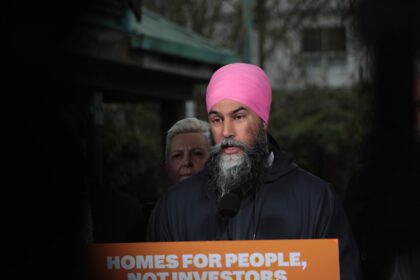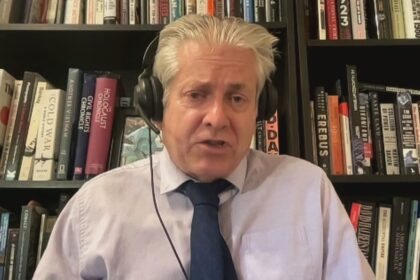Cold Lake First Nations Chief Kelsey Jacko says Alberta Premier Danielle Smith will have some questions to answer when Treaty 6 chiefs meet with her on May 6. The 17 chiefs are concerned about a number of issues, but the main one is renewed talk of Alberta separating from Canada following the Liberals minority win in the federal election. “We never even had meaningful talks about this. It’s kind of hard to deal with this government,” Jacko said in an interview with APTN News. “They talk about a lot of stuff-they pass bills and everything and they try to come consult us after. That’s not right.” On Thursday, Smith deflected accusations that she’s stoking the fires of separatism, despite her government moving to lower the bar for holding a referendum. A minority but vocal set of right-wing supporters are pushing for an Alberta exit from Confederation following the federal Liberals’ election win on Monday. Among the proposed changes to Alberta’s referendum act is reducing the required number of signatures on a citizen led petition from 20 per cent of eligible voters to 10 per cent and giving those behind a petition 120 days instead of just 90 to gather the required number. Asked by reporters if she would acknowledge that she has opened the door for separatism to gain ground in the province, Smith pointed to recent polling that pegged support at 25 per cent, or 30 per cent with a federal Liberal election win. Still, Jacko said all First Nations in Alberta are united in fighting the government on this issue. “Treaty 6, 7 and 8 – this is something we’ve always been fighting. We never gave up,” Jacko said. “There’s no bill of sale for this land of Alberta-they call it. We had no say in the making of Alberta and Saskatchewan. They didn’t consult us.” A similar message was delivered by Assembly of First Nations National Chief Cindy Woodhouse-Nepinak to a meeting of Manitoba chiefs. “If people aren’t happy in this beautiful country that we are building together then you are free to go and live wherever you want,” Woodhouse-Nepinak said. “But you can take the dirt that maybe your ancestors brought with them when they came over here from other places but that’s the only piece of land you are going to take. But you are not going to take any treaty land, any inherent land from any of our First Nations people across our beautiful country.” Cree nation of Quebec and separation This is not the first time First Nations have led the fight against separatist movements while Cree nations in Quebec have asserted their sovereignty. The separatist movement in Quebec gained traction in the late ’70s with a referendum on the question in 1980 and again in 1995. Many French-speaking residents of Quebec argued they had a distinct history, religion, traditions and cultural identity from the rest of the country. Both referendums failed. One of those pushing back was Bill Namagoose, from Waskaganish Cree Nation in Quebec. Namagoose is the former executive director of the Cree Nation Government and Grand Council of the Crees (Eeyou Itschee). Namagoose says the Crees fended off separation by Quebec in 1995 by asserting their right to self-determination and recognizing their distinctiveness. The grand council continues to assert its inherent right to self-determination, meaning the right to govern itself and make decisions about its own future, but that same right does not apply to provinces. “There’s no such thing as a right to self-determination for a city or a province – it belongs to the people. To the nation,” Namagoose said in an interview with APTN. “I think that’s the strongest card, the only card that we had to play in Quebec.” The Cree Nation held its own referendum for Cree voters to express their opposition to Quebec secession. The Cree voters overwhelmingly chose to remain in Canada, with over 96 per cent voting against following Quebec. “In North America-there are only three boundaries that are protected by international law-Canada-U.S. and Mexico-boundaries like Texas-Florida-Alberta-B.C.-Quebec-all those are administrative boundaries within those internationally protected borders.” On Wednesday, two Cree First Nations-Sturgeon Lake in Saskatchewan and Mikisew in northeastern Alberta issued a news release calling on the Smith government to cease and desist in its separatist threats. “You are attempting to manufacture a national unity crisis-by enabling a referendum on separatism and a fanatical cell of individuals-at the exact moment when Canadians need to unite against Donald Trump’s Americans,” Chief Sheldon Sunshine of Sturgeon Lake Cree Nation and Mikisew Cree Nation Chief Billy-Joe Tuccaro said in the release. They went on to say the treaties are “sacred covenants that are to last forever” and the province does not have the authority to “supersede or intervene” with the treaties “even indirectly by passing the buck” to a citizen led referendum. Namagoose says First Nations in Alberta should rely on their right to self determination. “Some of those treaties are big ones but the right to self determination is an internationally recognized law. A nation is a people that have a common culture, common language, a distinct territory and a common desire to live together,” Namagoose says. “Alberta is not a nation, it’s a province.” Tags: Alberta, Bill Namagoose, Chiefs, Cold Lake First Nations, Eeyou Itschee, Grand Council of the Crees, Kelsey Jacko, Premier Danielle Smith, Referendum, seccession, self-determination, separatist, Treaty 6, Waskaganish Cree NationCrees Continue Reading
Treaty 6 chiefs to press Alberta premier to back down on separatist rhetoric

Leave a Comment









